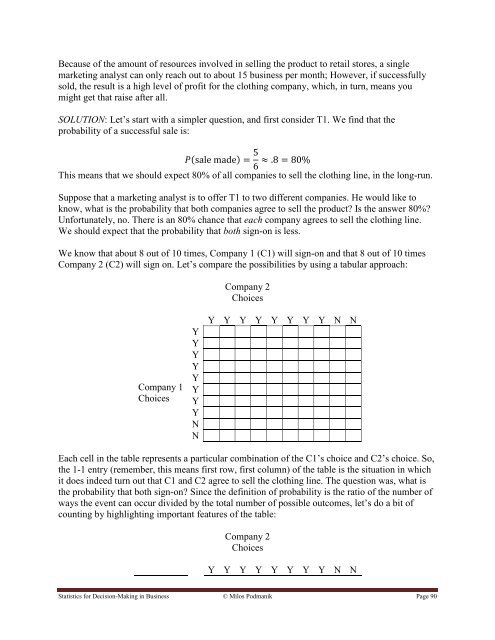Statistics for Decision- Making in Business - Maricopa Community ...
Statistics for Decision- Making in Business - Maricopa Community ...
Statistics for Decision- Making in Business - Maricopa Community ...
Create successful ePaper yourself
Turn your PDF publications into a flip-book with our unique Google optimized e-Paper software.
Because of the amount of resources <strong>in</strong>volved <strong>in</strong> sell<strong>in</strong>g the product to retail stores, a s<strong>in</strong>gle<br />
market<strong>in</strong>g analyst can only reach out to about 15 bus<strong>in</strong>ess per month; However, if successfully<br />
sold, the result is a high level of profit <strong>for</strong> the cloth<strong>in</strong>g company, which, <strong>in</strong> turn, means you<br />
might get that raise after all.<br />
SOLUTION: Let‟s start with a simpler question, and first consider T1. We f<strong>in</strong>d that the<br />
probability of a successful sale is:<br />
( )<br />
This means that we should expect 80% of all companies to sell the cloth<strong>in</strong>g l<strong>in</strong>e, <strong>in</strong> the long-run.<br />
Suppose that a market<strong>in</strong>g analyst is to offer T1 to two different companies. He would like to<br />
know, what is the probability that both companies agree to sell the product Is the answer 80%<br />
Un<strong>for</strong>tunately, no. There is an 80% chance that each company agrees to sell the cloth<strong>in</strong>g l<strong>in</strong>e.<br />
We should expect that the probability that both sign-on is less.<br />
We know that about 8 out of 10 times, Company 1 (C1) will sign-on and that 8 out of 10 times<br />
Company 2 (C2) will sign on. Let‟s compare the possibilities by us<strong>in</strong>g a tabular approach:<br />
Company 2<br />
Choices<br />
Company 1<br />
Choices<br />
Y<br />
Y<br />
Y<br />
Y<br />
Y<br />
Y<br />
Y<br />
Y<br />
N<br />
N<br />
Y Y Y Y Y Y Y Y N N<br />
Each cell <strong>in</strong> the table represents a particular comb<strong>in</strong>ation of the C1‟s choice and C2‟s choice. So,<br />
the 1-1 entry (remember, this means first row, first column) of the table is the situation <strong>in</strong> which<br />
it does <strong>in</strong>deed turn out that C1 and C2 agree to sell the cloth<strong>in</strong>g l<strong>in</strong>e. The question was, what is<br />
the probability that both sign-on S<strong>in</strong>ce the def<strong>in</strong>ition of probability is the ratio of the number of<br />
ways the event can occur divided by the total number of possible outcomes, let‟s do a bit of<br />
count<strong>in</strong>g by highlight<strong>in</strong>g important features of the table:<br />
Company 2<br />
Choices<br />
Y Y Y Y Y Y Y Y N N<br />
<strong>Statistics</strong> <strong>for</strong> <strong>Decision</strong>-<strong>Mak<strong>in</strong>g</strong> <strong>in</strong> Bus<strong>in</strong>ess © Milos Podmanik Page 90
















